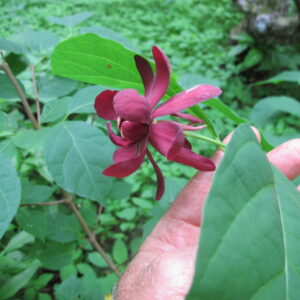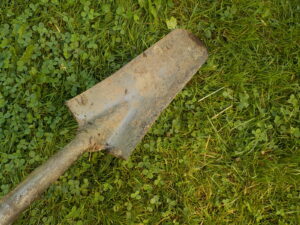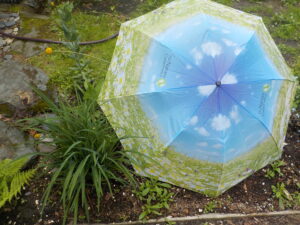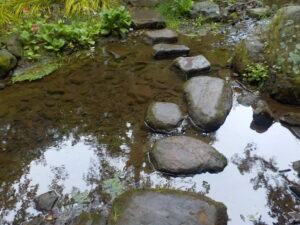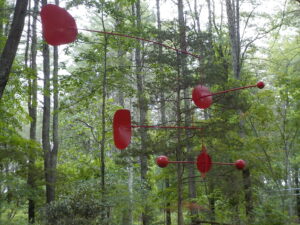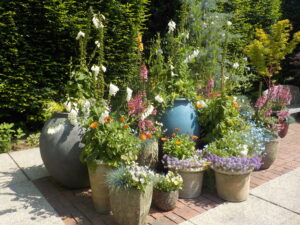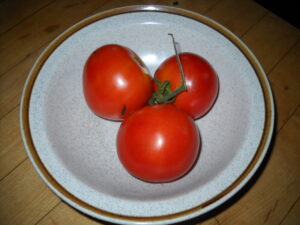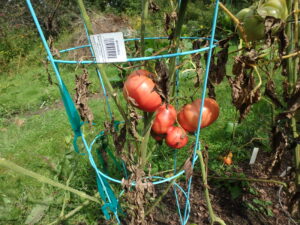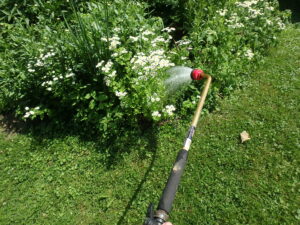Growing Plants for Their Scents Makes Sense
Posted on Friday, June 30, 2023 · Leave a Comment
Do you remember your Grammy’s favorite rose? If you do, you probably remember how fragrant it was. For me, one of my grandmother’s favorite plants was the peony named ‘Festiva Maxima’. It is a double white with a drop of red in the middle. It’s in bloom now, with a fragrance so pleasant it almost makes me swoon. And even though she passed away in 1953, her peony has been divided and shared, and I have a piece of it, which I treasure.
My friend Nelia Sargent of Claremont, NH is an excellent gardener, growing trees, shrubs, perennials and annuals. She specializes in plants with fragrant flowers because she has been blind since she lost her sight while in college decades ago. I called her recently to see what flowers please her the most in spring, summer and fall. Let’s take a look.
Spring: Early each spring one of Nelia’s first bloomers is a witchhazel named ‘Arnold’s Promise’. Even though it is a Zone 5 plant (hardy to minus 20 degrees) and we are in a Zone 4 area, her home is within a mile of the Connecticut River, which tempers winters a bit. Arnold’s Promise blooms for her in April and, she said, one stem will fill a room with fragrance for up to two weeks in a vase.
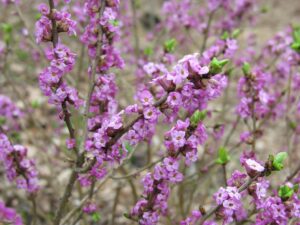
Close-up of February Daphne taken in late March
Another favorite of hers is February daphne (Daphne mezereum), which blooms here in late march into April. It is a small shrub that is relatively slow-growing and short lived. She says they are good for 10 years, but I’ve had one for 20. It is very fragrant and has lovely lavender flowers. All daphnes are fragrant and she also like Daphne burkwoodii, which blooms in May.
Viburnums are also fragrant shrubs grown by Nelia. She particularly like Viburnum judii and V. carlessii. The first, also called Judd’s viburnum, has semi-snowball bloom clusters that are pink in bud and white when open. It grows in full sun or part shade, as does Korean spice viburnum (V. carlessiii). Both prefer well drained rich soil in sun and stay a tidy 6- to 8- foot height and width. I grow the second and have had mixed luck with it: it is not always very generous with its blossoms, and does develop dead branches at maturity.
Summer: This is the season that has the most kinds of fragrant blossoms. Nelia has developed such a keen sense of smell that she was once invited to “smell test” and rate the lilacs at the Arnold Arboretum at Harvard.
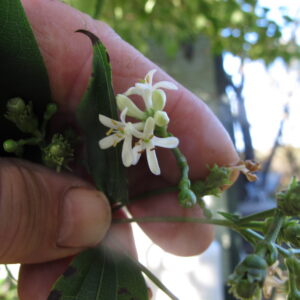
Seven Sons Flower Tree blossoms are small, but lovely.
Nelia told me that there are about 20 different fragrances from lilacs, each distinct. Her favorite lilacs are called ‘Sister Justina’, ‘Gertrude Lesley’, and ‘Miss Kim’. Miss Kim is often sold as a miniature, but it is really just slow-growing. Mine, now 25 years old, is about 12 feet tall and wide. The fragrance is lovely – I can smell it from 20 feet away, and on a sunny day it is loaded with butterflies and bees.
Then there are peonies. Properly planted, peonies last forever. And, as Nelia said, ”You can plant peonies for your heirs, but they yield immediately.” Purchase your peonies now, while in bloom at the garden center so you can see if they are fragrant –not all are – and see what they look like. Just don’t plant them so deep that their nibs or growing points are covered with more than an inch of soil, or they will not bloom in the future.
Nelia’s favorite peonies are Dawn Glow, Madame Deveronvale, Edulalis Superba (a very early deep pink), Festiva Maxima, Duchess De Nemours, and Carnation Bouquet (spicy, with a “carnation appearance”).
Mock orange (Philadelphus spp.) is a group of shrubs composed of about 20 species that are very fragrant. But they are a bit unruly and not suited for prime real estate in the garden. Nelia suggest planting them a bit away from the house, and letting them naturalize. I’ve never grown it myself due to its spreading behavior.
Late Summer and Fall: Many fall flowers are big, tall, bright – but not very fragrant. Here are few she likes.
Clethra: A nice shrub that likes moist places. She particularly likes ‘Ruby Spice’, which is a reddish one.
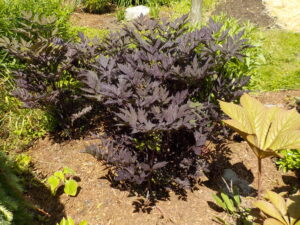
The foliage on ‘Hillside Black Beauty’ is nearly black and later it will have fragrant white bottlebrush flowers
Cohosh (formerly Cimicifuga spp., now included in the genus Actea): This plant has tall flower spikes that display drooping bottlebrush flowers. Bees absolutely love it. There is a black-leafed species that is quite distinctive called Hillside Black Beauty.
Seven Sons-Flower Tree (Heptacodium miconioides) starts blooming in September and may continue into October unless there is a bad frost. The blossoms are small and white, and delicately fragrant. I grow it for the bark as well, which is exfoliating and interesting all winter.
So, if you like fragrant flowers, try some of Nelia Sargent’s favorites. All are wonderful.
Henry is the author of 4
gardening books and a
gardening consultant. He lives and
gardens in Cornish Flat, NH. Reach him at
henry.homeyer@comcast.net.
The Gardener’s Bane: Slugs, Bugs and Ticks, Oh My!
Posted on Wednesday, June 28, 2023 · Leave a Comment
All gardeners have to contend with a variety of insects and other small pests in the garden – those that attack our plants and those that bite us. Mosquitoes? I can live with them. But ticks? That is another story.
I’ve tried every kind of spray to repel ticks and prevent bites. I haven’t found any that are 100% effective. There are lots of “all natural” ones out there, but it is hard to tell how effective they are. I don’t like sprays with Deet in them, but believe they probably are better at repelling ticks than the herbal applications. But I don’t rely just on repellents.
When I am working in brushy areas I wear long pants: lightweight quick-dry nylon. Then I either tuck the pants into my socks or wear some special tick gaiters. The ones I use are called Lymeez. According to their advertising, they are a mesh treated with EPA-registered micro-encapsulated permethrin tick repellent and closed with Velcro. LL Bean and other suppliers also sell clothing treated with permethrin to kill or repel ticks, mosquitoes and other insects.
From what I have read, permethrin not only repels ticks, it kills them. I have read about “tick tubes” treated with permethrin to kill the ticks on mice – a vector for Lyme. These little tubes contain treated cotton balls that mice bring to their nests, where the permethrin kills the ticks. I plan to get some for my woodpile.
Slugs and shell-covered small snails are always a problem in my garden. I usually keep a jar of soapy water in the garden near my lettuce, which is the preferred treat for these nasty critters. Pick and drown works.
Another garden pest is the Colorado potato beetle. This striped beetle can decimate the leaves of potatoes if you don’t control them early, even killing the plant or reducing your crop. The beetles are yellowish with black stripes, the larvae are beige to red with rows of black dots. The eggs are orange and generally found on the underneath side of the leaves. It is important to pick these pests early as they mature quickly and each female lays many eggs – multiplying their impact quickly if not controlled.
If you have too many potato plants to hand pick them all, there is a biological control called Bt. It is a bacterium that is diluted in water and sprayed on the plants. It is not a contact poison, it needs to be consumed by the larvae when they are young. They sicken, stop eating and die. But you may need to use it for a few years to really solve the problem. There are several different Bt formulas, so be sure you get one labeled for potatoes.
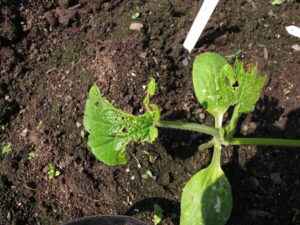
Leaves eaten by striped cucumber beetle
Striped cucumber beetles look a bit like potato beetles, but they are smaller and fast moving. They can strip all the leaves off your vine crops in a single night if they are present in the soil when your cukes or squash-family plants first germinate. You can cover the crops with row covers to keep them away, but they may already be present in the soil. Me? I start my vine crops indoors and only plant them when they have at least a six-inch long vine and can’t be killed by the beetles.

Larvae of parasitic asp on tomato hornworm will kill it
My least favorite pest is the tomato hornworm. Big, up to four inches long, they are aggressive when you pick them up. There is a natural predator, a parasitic wasp that lays eggs in them. So if you see what looks like grains of rice on them, just remove them to a faraway part of the garden. Those “grains of rice” are larvae that will suck them dry and keep them from reproducing. You can make or buy houses for these wasps and other good wasps and hang it on your shed. These are simply a collection of hollow bamboo pieces they can use to for shelter.
A good reason NOT to use insecticides is that they will inadvertently kill good bugs like lady beetles, spiders, praying mantises and more. You’ve probably never seen an assassin bug, but they are relentless killers of bad bugs, sucking them dry.
Many of us grew up thinking that most bugs, beetles, moths and other insects are harmful. For a long time my first inclination on seeing an insect in the garden was to squish it. Not anymore. Mother Nature tries to create a balance that keeps pests from taking over. Unless you know an insect is a pest – think Japanese beetle, rose chafer, striped cucumber beetle – leave it be. It might be the critter that controls others from decimating your garden.
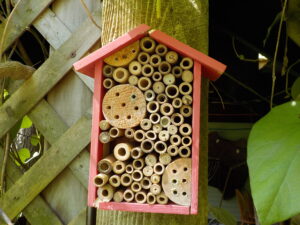
This simple structure provides a place for beneficial solitary wasps to lay eggs
If you want to learn about the bugs you see, you might want to pick up a copy of a nice small paperback called, “Good Bug, Bad Bug: Who’s Who, What They Do, and How to Manage Them Organically” by Jessica Walliser. It is well illustrated and also tells you how you can attract good ones– or even purchase them.
Being an organic gardener means you have to pay attention. Watch for problem pests and try to control them before they can ruin your flowers or veggies. And never use a chemical pesticide as it will throw everything out of balance.
Henry is a lifelong organic
gardener, and a 20-year veteran of the UNH Master
Gardener program. He is the author of 4
gardening books and a
gardening consultant. Reach him at
henry.homeyer@comcast.net.
Once, a long time ago, I was sitting on a porch overlooking a landscape with an acquaintance. I commented that if she removed or thinned a line of tall pine trees, she would have a lovely long view. “Great idea! I’ll have them moved,” she said. Even though she was a woman of means, I explained that it wouldn’t be possible to move 60-foot white pines. She should either live with them or cut some down.
On the other hand, I move shrubs and perennial flowers regularly. Done right, a plant barely knows it’s been moved. I have a number of reasons for moving a plant.
First, if the plant is not growing well. Perhaps the tag on it said, “Sun or Part shade.” Well, what is part shade? I define full sun as 5 or 6 hours of afternoon sun. Morning sun is less hot, and a sun-lover might want some afternoon sun in addition to the morning sun.
Why else move a plant? We all change our minds. Or plants grow and start to crowd out their neighbors. We get new plants and decide to plant one where something else is already growing. Moving plants is a normal part of gardening.
For the next three years or more my sweetshrub did not burn up in summer, but neither did it flower much. I wanted those deep burgundy wine-colored blossoms, each more than an inch across. So I finally moved it again – this time under a pear tree that allowed filtered sunshine. Perfect! It has bloomed magnificently ever since.
My technique for moving a shrub is simple. I decide where it should go, and get the area ready by removing grass or plants and loosening the top layers of soil. Then I go to the plant if question with a drain spade that has a blade 16 inches long and only 5 inches wide. I slide it under the shrub on all four sides by thrusting the blade into the soil at a 45 degree angle. On each side I give the spade a gently downward push to lift and loosen the shrub a little. By the fourth thrust, it should be ready to lift out by sliding my two hands under the root ball.
When I water a plant I have moved, I add something to the water: a capful (half a teaspoon) of something called “Superthrive” in a watering can of water. It was developed some 70 years ago and uses seaweed extracts and plant hormones to lessen transplant shock. I find it really helps. A small blurt of Neptune’s Harvest Fish and Seaweed fertilizer in the water adds some quick nutrition. I use both liquids on all my vegetables as I plant them, too.
Any plant that you planted this year can be moved now without damaging it. It takes several weeks before roots move far from their rootball. I don’t bother with a spade when moving new things. I use my CobraHead weeder which is shaped like a long curved finger. It gets under the rootball easily, and by wiggling it around I can loosen the plant and gently lift it out, pulling from below with my CobraHead.
Peony roots go deep, and are not easy to move without breaking their fleshy tubers. Peony experts say to move them in the fall, when they are going dormant. But I once moved a hedge of peonies in June with about 50 plants, and not one showed ill-effects.
It is best to move established perennials in the early evening, or on a cool or drizzly day. Some plants go into shock if disturbed in the heat of the day, so avoid doing so if you can. Others, like daylilies, don’t care at all about being moved on a hot dry day.
I recently was planting my front walkway garden and noticed a Rudbeckia called ‘Prairie Sun’ that was too close to another plant, so I moved it at 11am on a hot day. After lunch the leaves were limp and it was in distress. My solution? I gave it another drink of Superthrive and placed an umbrella over it to provide shade. By the next morning it looked like it had never been moved!
So go ahead, move plants. Other than big trees, there are very few you can’t move.









